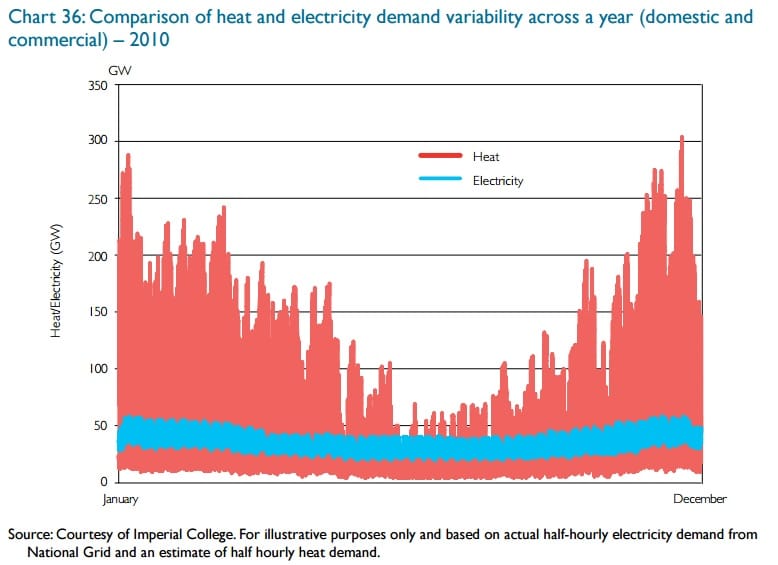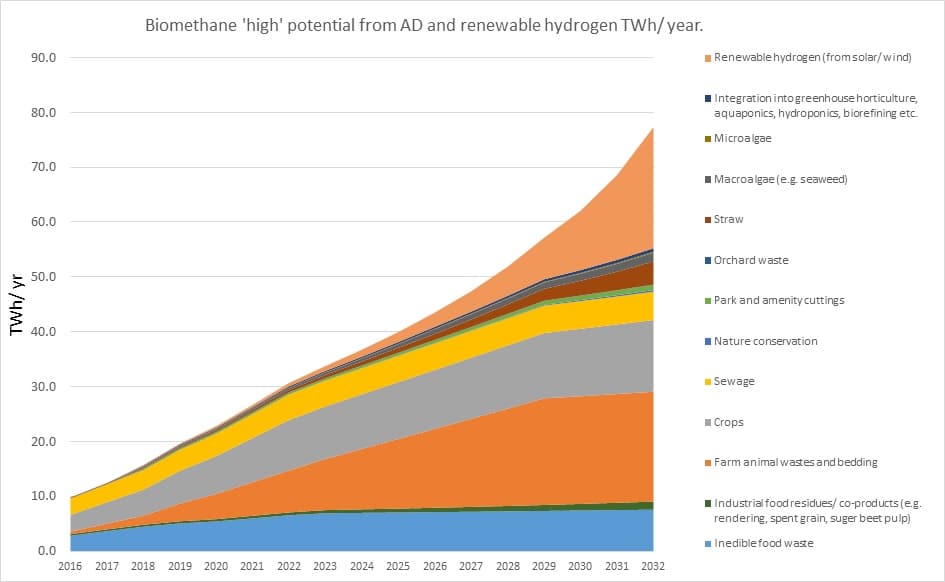The International Energy Agency recently issued its second Outlook for Biogas and Biomethane. It concluded…
Heat decarbonisation and the role of new AD feedstocks
At some point in the next decade, the government will need to decide how it will largely decarbonise heat by 2050. Clearly the assumption behind this statement is that they remain committed to decarbonisation. Decarbonising the electricity grid will look like a piece of cake compared to the heat sector. And this is before we’ve even got to trying to use some renewable resources for transport.
The government will have to choose between three broad strategic options – simplified here:
1. Electrification of heat and use of heat pumps. I'd expect the cost of this to be prohibitive. As the below chart from Imperial College shows, peak heat use is something like six times peak electricity use – building all that electrical generating and grid capacity is inconceivable, even if we somehow manage to cut peak heat use by something like 50%.

2. A largely hydrogen grid. i.e. buying natural gas from Norway, Qatar, Algeria and UK shale gas producers and capturing the carbon from the methane. The UK won't have North Sea gas reserves by then. We then pipe that carbon out to the North Sea and store it under the seabed. We'd need to upgrade the gas network to ensure the hydrogen doesn't leak (work is underway on this but it's unclear how much hydrogen the grid will be able to accept). We'd then need to convert all of our boilers to hydrogen (although less intrusive methods may become available – but it's a big ask). As Caroline Flint, the former Shadow Energy Secretary, said at our ADBA National Conference last December, politicians don't see many votes in sending gas engineers into every house and business to replace their boilers unless all other options have been exhausted. It is worth pointing out, though, that new boilers could be designed to make this conversion easier.
The carbon storage part of this is also unrealistic in my view given the lack of progress on this in the last 10 years.
3. So can we continue with a largely methane grid, supplemented by a few heat networks? Roughly 400-500 TWh per year are currently needed for heating and industry use. We could hopefully reduce this demand (e.g. through insulation) – by how much we don't know. Using all the UK's appropriate food waste, sewage, manures and some crops could provide over 40 TWh across the year (as the below ADBA chart shows). Other sources of methane from renewable sources such as the gasification and methanation of imported wood could help but questions remain over how much wood can be extracted from American forests sustainably. There may be UK sources of feedstock for gasifying and methanating, but the UK wood resource is limited and, once paper and food waste are taken out of our black bin bags for recycling and AD, there shouldn't be a great deal of renewable (biological) material remaining for biomethane production via gasification by 2050. By 2050 all packaging will need to be recyclable, digestible or compostable.

So renewables on current feedstocks are unlikely to be able to provide the energy required for us to have a methane grid in future while meeting carbon targets. Clearly, new renewable feedstocks are needed.
Where should they come from?
- One source is methane produced from combining (using microbes) the carbon dioxide (produced as a by-product of biogas upgrading) with hydrogen (produced from the electrolysis of water using electricity from solar and wind at times when their supply exceeds UK or local demand). Sandra Esteves of the University of South Wales is an expert in this will be speaking at UK AD & Biogas and World Biogas Expo 2017 . Anyone interested in this topic needs to speak to Sandra. You can also visit the Schmack Biogas stand – they have a demonstration plant operating in Germany.
- Seaweed (macroalgae) – the Centre for Process Innovation (CPI) and others have been working on how to grow seaweed commercially and process it through AD. Clearly growing a crop in the sea has fewer spacial limitations than land and can be integrated into food production (e.g. to clean up the waste from fish farms). How much can we grow? Hopefully the SeaGas project can give us a few answers. Michelle Morrison of the CPI will be talking about this on day 1 of UK AD & Biogas and World Biogas Expo 2017 at our Research and Innovation (R&I) Hub. The R&I Hub is where researchers and innovators talk about how their research is transforming the AD industry.
- Straw – although woody, we've been making progress with breaking down the lignin to allow for it to be used in anaerobic digestion. Future Biogas have installed a pre-treatment technology for this and you can find their stand at the trade show. And another member of ours, Singleton Birch, will be talking at the R&I Hub about their trials using maize and straw.
- Park and amenity cuttings. There are thousands of miles of roadside verges in the UK, currently a cost to councils to maintain. Could the grass grown be used for biogas production? Well Dr Nick Cheffins of Peakhill Associates thinks so, and he's working with Lincolnshire County Council to make this the norm. It should be simple enough, but Nick will be talking at our R&I Hub about the challenges that he's had to overcome to get the market moving.
How does it all add up?
With these and a few other feedstocks in the chart above, we could produce 80 TWh per year of biomethane from AD and intermittent renewable electricity. That will not be enough to decarbonise the gas grid – but it does show why, as an industry and as a country, we need to be commercialising these potential feedstocks. Without them the future of heating in the UK looks expensive and/ or fossil.
I'll be making this point at the various energy, heating and biomethane discussions we'll be having at our trade show.
